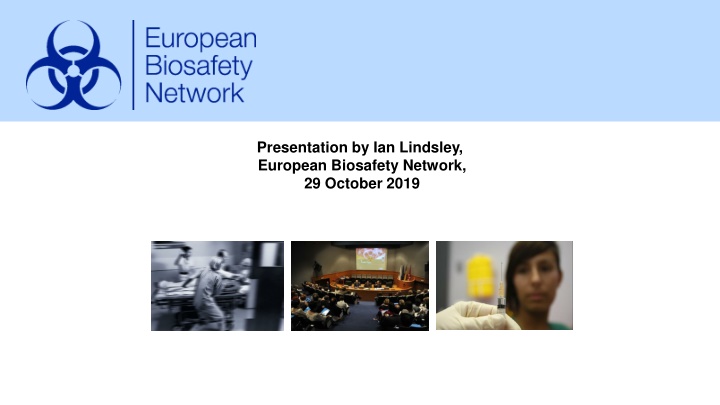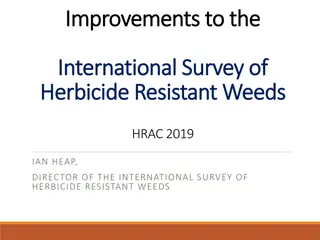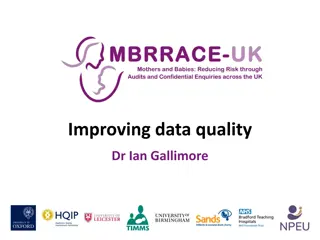
European Biosafety Network: Promoting Biological and Occupational Safety in Healthcare
"Learn about the European Biosafety Network, established in 2009, to promote biological and occupational safety in healthcare throughout the European Union. Discover their activities, engagement with stakeholders, and advocacy for protection from hazardous drugs."
Download Presentation

Please find below an Image/Link to download the presentation.
The content on the website is provided AS IS for your information and personal use only. It may not be sold, licensed, or shared on other websites without obtaining consent from the author. If you encounter any issues during the download, it is possible that the publisher has removed the file from their server.
You are allowed to download the files provided on this website for personal or commercial use, subject to the condition that they are used lawfully. All files are the property of their respective owners.
The content on the website is provided AS IS for your information and personal use only. It may not be sold, licensed, or shared on other websites without obtaining consent from the author.
E N D
Presentation Transcript
Presentation by Ian Lindsley, European Biosafety Network, 29 October 2019
About the EBN Established in 2009 by the founding partners, the Spanish General Council of Nursing and the British public services union UNISON. The Network is an inclusive organisation made up of national and European professional institutions, representative associations, unions and other interested parties committed to biological and occupational safety in healthcare throughout the European Union.
The European Biosafety Network - Activity Engaging with and bringing together: Healthcare and non-healthcare workers and their representatives at the European and national level, healthcare management, leading academics and experts, national governments and coalitions of stakeholders, the European Commission, the European Parliament, Social Partners, the European Agency for Safety and Health at Work, government agencies and other important stakeholders. Raising awareness, providing information, guidance on implementation, risk assessment and prevention, education and training, reporting and monitoring and public policy work.
The 2nd European Biosafety Summit 1 June 2011, Dublin
Background on Hazardous Drugs The European Commission said that in 2012 up to 106,500 cancer deaths were attributed to occupational exposure to carcinogenic substances, making cancer the first cause of work-related deaths in the EU. Every year more than 12.7 million health workers, mostly women, in Europe are potentially exposed to carcinogenic, mutagenic and reprotoxic hazardous drugs, including cytotoxic or antineoplastic drugs. The health hazard for handling these drugs is well documented, a major concern as they are not only classified as carcinogenic, but also mutagenic (mutating genetic material) and reprotoxic (interfering with reproduction). Cytotoxic drugs used to treat cancer in patients are generally nonselective and are therefore likely to damage normal cells too for patients and exposed workers. The EBN is arguing for protection for all workers and patients from occupational exposure to hazardous drugs but most of the research and data relates specifically to healthcare workers, who are mostly women.
Background on Hazardous Drugs Studies show that nurses exposed to cytotoxic drugs are twice as likely to miscarry and that hospital workers who handle cytotoxic drugs are three times more likely to develop malignancy. Increased genetic damage has been demonstrated in nurses, particularly in day hospital nurses, the group handling the highest amount of drugs during the administration process. As cancer often takes decades to emerge, a case of leukaemia diagnosed in a nurse or in a pharmacist today might be the product of workplace exposures in the 1970s or the 1980s. Threshold levels of exposure cannot be predicted and therefore contact with genotoxic (gene destroying) carcinogens should be avoided at all levels.
Risk of occupational exposure to Hazardous Drugs From the NIOSH Alert 2004-165 - www.cdc.gov/niosh/docs/2004-165/pdfs/2004-165.pdf Several reports have addressed the relationship of cancer occurrence to health care workers exposures to antineoplastic drugs. A significantly increased risk of leukemia has been reported among oncology nurses identified in the Danish cancer registry for the period 1943 1987 [Skov et al. 1992]. The same group [Skov et al. 1990] found an increased, but not significant, risk of leukemia in physicians employed for at least 6 months in a department where patients were treated with antineoplastic drugs. Skov T, Maarup B, Olsen J, R rth M, Winthereik H, Lynge E [1992]. Leukaemia and reproductive outcome among nurses handling antineoplastic drugs. Br J Ind Med 49: 855 861. Skov T, Lynge E, Maarup B, Olsen J, R rth M, Winthereik H [1990]. Risk for physicians handling antineoplastic drugs [letter to the editor]. The Lancet 336:1446
Risk of occupational exposure to Hazardous Drugs A Dutch study (Fransman 2014) that shows a model of an increase of 154 deaths from leukemia per million nurses working with the cytotoxic drug cyclophosphamide. Another study, Ratner 2010 shows increased incidence of breast cancer (RR = 1.83; 95% CI = 1.03 - 3.23, 12 cases) and rectal cancer (RR = 1.87, 95% CI = 1.07 - 3.29, 14 cases) in nurses working in a cancer centre. Fransman W, Kager H, Meijster T, Heederik D, Kromhout H, Portengen L and Blaauboer BJ. Leukemia from dermal exposure to cyclophosphamide among nurses in the Netherlands: quantitative assessment of the risk. Ann Occup Hyg. 2014; 58:271-282. Ratner PA, Spinelli JJ, Beking K, Lorenzi M, Chow Y, Teschke K, Le ND, Gallagher RP, Dimich-Ward H. Cancer incidence and adverse pregnancy outcome in registered nurses potentially exposed to antineoplastic drugs. BMC Nurs. 2010; 9:15.
Observatory on Hazardous Drugs The EBN has developed a European Observatory on occupational exposure in the preparation, administration and disposal of hazardous drugs in healthcare. The Observatory study conducted from September 2018 by Ipsos MORI into the current state of the protocol and procedure surrounding hazardous drugs, including cytotoxic drugs, in European Oncology. The final report covers 14 EU countries drawn from across the EU Spain, Portugal, France, Italy, Denmark, Latvia, Estonia, Netherlands, UK, Belgium, Ireland, Poland, Germany, Sweden. Data is drawn from a representative sample with the responses of 147 heads of hospital pharmacies and 142 oncology outpatient unit supervisors/managers. As this survey sampled a largely self-selecting group, the reality of awareness and compliance may be worse than the headline survey results.
Conclusions for Hospital Pharmacies Increase the use of risk assessments as a key proactive exposure prevention measure (currently employed by just 84% of hospital pharmacies) Promote the active recording of incidents involving hazardous drugs to avoid issues being ignored Ensure that decontamination protocols are in place in all pharmacies - a measure that 11% of hospital pharmacies still lack Increase levels of training for patients and caregivers, which are currently falling a long way behind the levels of training offered to staff and are a high exposure risk Increase medical surveillance, particularly in Western European countries. Regular medical testing, for example, is only carried out regularly in 62% of the pharmacies, falling to 20% in the UK, 30% in France, for example Ensure that hazardous drugs are universally prepared in hospital pharmacies rather than in wards - currently 21% of preparation is carried out outside the pharmacy area
Conclusions for Hospital Pharmacies Ensure that sterile rooms used in the preparation of hazardous drugs are equipped with either a Biological Safety Cabinet (BSC) or an Aseptic Isolator (AI) -9% of pharmacies revealed that this was not the case, with low results especially in Eastern Europe. Further, the use of CSTDs should be required as recommended by the World Health Organization to protect worker and patient safety Regular monitoring of surface contamination should be universal, more frequent and more comprehensive - this is currently only carried out in 55% of hospital pharmacies, and where it is carried out it is often infrequent and superficial Formalise a European list of hazardous drugs currently the National Institute for Occupational Safety and Health (NIOSH) list is used but this is based on non-European criteria and is insensitive to the particulars of the European oncology environment To achieve these recommendations, hazardous drugs should be included in the Carcinogens and Mutagens Directive EU 2004/37 combined with mandatory European guidelines and a European list of hazardous drugs
Conclusions for Oncology Outpatient units Increase the use of risk assessments as a key proactive exposure prevention measure (currently employed by 90% of oncology outpatient units) Promote the active recording of incidents involving hazardous drugs to avoid issues being ignored Ensure that preparation of hazardous drugs and spiking of medication bags is carried out in the hospital pharmacy - currently only 86% of the preparation and 61% of the spiking of medical bags occurs in pharmacies, meaning that many workers in wards are exposed to the risk of spillages and leakages Eliminate the use of outdated administration systems and promote the use of closed systems offering full protection, such as CSTDs Increase the use of all forms of personal protective equipment (PPE) where appropriate - this is critical to worker safety, but most measures fail to be employed by approximately 25% of units Increase levels of training for patients and caregivers, which are currently falling a long way behind the levels of training offered to healthcare staff but who are also at high exposure risk
Conclusions for Oncology outpatient units Increase regular medical testing, particularly in Western European countries - it is only carried out regularly in 58% of the units, falling to 33% in Ireland, 35% in France, for example Regular monitoring of surface contamination should be universal, more frequent and more comprehensive -this is currently only carried out in 55% of oncology outpatient units Ensure a universal protocol for the cleaning of administration areas - currently this only exists in 82% of units and is essential for the maintenance of a safe environment for staff and patients To achieve these recommendations, hazardous drugs should be included in the Carcinogens and Mutagens Directive EU 2004/37 combined with mandatory European guidelines and a European list of hazardous drugs
Carcinogens and Mutagens Directive Directive 2004/37/EC The Carcinogens and Mutagens Directive of 29 April 2004 on the protection of workers from the risks related to exposure to carcinogens or mutagens at work has been subject to two revisions and the third batch of amendments will conclude this month. Provisions of the CMD include: The employer shall assess and manage the risk of exposure to carcinogens or mutagens Workers' exposure must be prevented. The employer shall reduce the use of carcinogens or mutagens by replacing them with a substance that is not dangerous or less dangerous. If replacement is not possible, the employer shall use a closed technological system.
Carcinogens and Mutagens Directive Directive 2004/37/EC Further provisions: Where a closed system is not technically possible, the employer shall reduce exposure to the minimum. The employer shall also provide appropriate training on potential risks to health, precautions to prevent exposure, hygiene requirements, protective equipment, clothing and incidents handlings. The Member States shall establish arrangements for health surveillance of workers if there is a risk to their health and safety. ANNEX I: List of substances, mixtures and processes ANNEX II: Practical recommendations for the health surveillance of workers ANNEX III: Limit values and other directly related provisions (in 2017 binding limit values and skin notations were reviewed/set for new agents)
Carcinogens and Mutagens Directive Directive 2004/37/EC On 5 June 2019, the third revision of the CMD included amendments recognising and prioritising for the first time the specific importance of protecting workers and patients who are exposed to such hazardous drugs, including cytotoxic drugs, through work involving: the preparation, administration or disposal of hazardous drugs, including cytotoxic drugs; services related to cleaning, transport, laundry or waste disposal of hazardous drugs or of materials contaminated by such drugs; or personal care for patients treated with hazardous drugs. This form of words ie work involving - is predicated on the language used to include a category of substances in Appendix 1 of the CMD not individual substances with limit values as in Appendix 3.
Carcinogens and Mutagens Directive 3 new sub-paragraph 6 Hazardous drugs, including cytotoxic drugs primarily used for cancer treatment, could have genotoxic, carcinogenic or mutagenic properties. It is therefore important to protect workers who are exposed to such drugs through work involving: the preparation, administration or disposal of hazardous drugs, including cytotoxic drugs; services related to cleaning, transport, laundry or waste disposal of hazardous drugs or of materials contaminated by such drugs; or personal care for patients treated with hazardous drugs. Hazardous drugs, including cytotoxic drugs, are subject to Union measures providing for minimum requirements for the protection of health and safety of workers, in particular those provided for in Council Directive 98/24/EC ( 6 ). Hazardous drugs that contain substances that are also carcinogens or mutagens are subject to Directive 2004/37/EC. The Commission should assess the most appropriate instrument for ensuring the occupational safety of workers exposed to hazardous drugs, including cytotoxic drugs. In doing so, access to the best available treatments for patients should not be jeopardised. [6] Council Directive 98/24/EC of 7 April 1998 on the protection of the health and safety of workers from the risks related to chemical agents at work (fourteenth individual Directive within the meaning of Article 16(1) of Directive 89/391/EEC) (OJ L 131, 5.5.1998, p. 11).
Carcinogens and Mutagens Directive 3 article 18a new sub-paragraph The European Commission is required by Q2 2020 to undertake a study and consultation on further amending the Directive to include hazardous drugs, including cytotoxic drugs and to present a legislative proposal. No later than 30 June 2020, the Commission shall, taking into account the latest developments in scientific knowledge, and after appropriate consultation with relevant stakeholders, in particular health practitioners and health professionals, assess the option of amending this Directive in order to include hazardous drugs, including cytotoxic drugs, or to propose a more appropriate instrument for the purpose of ensuring the occupational safety of workers exposed to such drugs. On that basis, the Commission shall present, if appropriate, and after consulting management and labour, a legislative proposal.
Requirements of the CMD The employer shall reduce the use of carcinogens or mutagens by replacing them with a substance that is not dangerous or less dangerous. In the case of occupational exposure to hazardous drugs, including cytotoxic drugs used to treat cancer in patients, replacement is not normally an option. Prevention and reduction of exposure If replacement of hazardous drugs is not possible, as is the case with most hazardous cytotoxic drugs, the employer shall ensure that the carcinogen or mutagen is manufactured and used in a closed technological system. In the context of occupational exposure to hazardous drugs in healthcare, the use of closed systems is technically possible. Sterile rooms used in the preparation of hazardous drugs, usually in hospital pharmacies, must be equipped with either a Biological Safety Cabinet (BSC) or an Aseptic Isolator (AI) and closed system drug transfer devices (CSTDs) and CSTDs must be used in the administration of hazardous drugs, usually by nurses on the wards of hospitals. Preparation of hazardous drugs and spiking of medication bags should be carried out in the hospital pharmacy not on the wards. Risk Assessment Reduction and replacement
Requirements of the CMD Information for the competent authority Unforeseen exposure Foreseeable exposure Access to risk areas Hygiene and individual protection Information and training of workers Information for workers
Requirements of the CMD Threshold levels of exposure to hazardous drugs cannot be predicted and it is therefore difficult to establish limit values. Therefore, contact with genotoxic carcinogens should be avoided at all levels, in accordance with the As Low As Reasonably Achievable (ALARA) principle, and also that is why hazardous drugs should be included as a work category in Annex I of the CMD not Annex III. Most of the studies performed on surface monitoring of hazardous drugs in Europe (eg, in Germany and Spain) suggest 0.1 ng/cm2 as the threshold level. In one Dutch study, urine samples from healthcare professionals who worked in facilities with contamination levels < 0.1 ng/cm2 were negative for one of the most widely used carcinogenic hazardous drugs cyclophosphamide. Consultation and participation of workers Health surveillance Record keeping Limit values
Conclusions The EBN expects that the scientific evidence and consultation with employers, workers and healthcare professionals over the course of the next year will justify and confirm the European Commission s anticipated action to include a list of hazardous drugs when it publishes its report and legislative proposal for the fourth batch of amendments to the CMD in 2020. The Commission has indicated in the past that it would prefer to include a limited number of individual hazardous drugs, including cytotoxic drugs, for inclusion in the CMD. The EBN and other major stakeholders would prefer that hazardous drugs are included as a category in Appendix 1. Whatever the conclusion of these discussions, healthcare systems in Europe and Italy need to be prepared to transpose and meet the new and existing requirements of the CMD in relation to how they manage these hazardous drugs now and in the future.
Requirements of the CMD The European Biosafety Network urges the European Commission to include in its report or to accept Parliamentary amendments for the revision of the CMD in 2020 that include hazardous drugs, including cytotoxic drugs, as a category in Appendix I. Healthcare workers and patients deserve to be protected by legislation now, not at some indeterminate time in the future, with the best possible systems of work, technology and education and training to avoid the risk of toxic and genetic damage and deadly diseases resulting from exposure to hazardous drugs.
66.30% 33.70% 17.46% 20.10% 35.07% 16.94% 83.06% www.europeanbiosafetynetwork.eu 64.93% 79.90% 32.10% 67.90% 82.54% 26.30% 73.70%

















